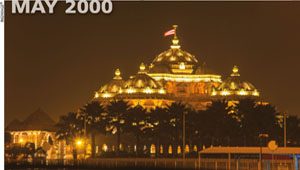THE ROVING DIPLOMAT
TRIBUTE SERIES
BREAKING THE ICE IN DELHI
President Bill Clinton’s visit to South Asia was meant to be inclusive

Clinton’s visit to South Asia raised a large number of sensitive issues about the future of South Asia and global relations with Europe. And in retrospect, it appears that his visit sought to rectify almost two decades of misunderstandings, miscalculations and missed opportunities from as far back as the Cold War era.
At a time when visits by presidents are commonplace, Clinton’s trip was built up into high drama. It was highlighted in the US and Indian media for weeks, leading to a chorus of expectations and excitement over the course and outcome of the visit.
The reason for such speculation was partly because it was the first visit by an American president to India in 22 years, suggesting that this was an extraordinary event. So why Clinton decided to take this step – and with what objectives – are crucial questions.
There is room to believe that this gap in top-level relations between the two countries was to some extent due to a kind of love-hate relationship that prevailed between them. After all, each is a power in its own right and it happened that in the course of events, they followed independent paths: the US as the superpower involved in the Cold War, and India standing for nonalignment, independence and universality.
An addition to this equation were certain diplomatic initiatives such as the close links of the US with Pakistan, as well as the defence alliance between India and the Soviet Union, which widened the gap. But with the end of the Cold War and resultant change in the international atmosphere, a new scenario has been created – and it could explain this development in Indo-US relations.
At the same time, this can also be attributed to Clinton’s unique and open-minded approach to world affairs. Being free of the constraints of the Cold War, he has endeavoured to project a universal image of the United States and its policies.
There’s also a pronounced emphasis on economic dimensions in the US President’s foreign relations as borne out in his support of Asia-Pacific Economic Cooperation (APEC), which is an overarching combination of North America, Europe, the Pacific and Southeast Asia.
In recent times, Clinton has shown a special interest in South Asia – conscious no doubt that there’s a gap in US relations in the region.
He has expressed concern about this, noting in a recent statement that South Asia is a dangerous continent. It amounted to an acknowledgement by Clinton of the emerging importance of South Asia and particularly India – not only in the Asian scene but also in global terms – and the necessity for him to meet this challenge.
Therefore, the decision to pay a state visit to India was a bold step for which he should be complimented.
As one would expect, there was much speculation about the specific purpose and occasion for this visit. In the prevailing context of South Asian affairs, it was assumed that the visit was intended to be a peacemaking mission that aimed to restore peace between India and Pakistan, as well as in the interests of South Asian security as a whole.
There was also the question of whether the visit would be limited to India in view of the natural interest of other South Asian countries – notably Bangladesh and Pakistan – and their possible inclusion. This was resolved by the decision to include Bangladesh and Pakistan in Clinton’s itinerary.
Looking back on the visit, there’s room to think that it was a relative success with which Clinton by and large realised
his objectives. But this is not to deny that there were setbacks at the outset. One was the massacre of 31 Sikhs in Kashmir on the eve of the visit that seemed to be a bad omen. There were also ongoing tensions in Kashmir and the fear of a conflict.
And of course, there was Pakistan’s anxiety that the US President should intervene in its problems with India – and the latter’s insistence that it will not permit any foreign intervention in its relations with Pakistan.



